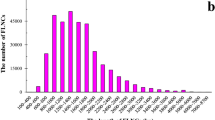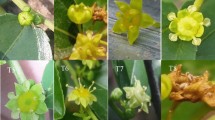Summary
Previous workers have obtained evidence suggesting that, under natural conditions, Papaver dubium reproduces by mixed selfing and random mating, the contribution of selfing being substantial. In order to obtain a more quantitative estimate of the amount of selfing, a small number of plants, homozygous or heterozygous for the recessive (flower colour) mutant, magenta, were raised among a large number of wild-type homozygotes and allowed to open pollinate. Progenies raised from these recessive homozygotes and from the heterozygotes, provided estimates of the degree of selfing. Results showed that the degree of selfing varies significantly, both between plants and between different flowers on the same plant. The estimates of average selfing obtained lay between 71 and 81 per cent, the estimates being about the same in two different years. In view of these and earlier results, it was concluded that a high degree of selfing obtains in natural populations of P. dubium; the degree of selfing being sufficiently large to have an important effect on the genetical structure of such populations.
Similar content being viewed by others
Article PDF
References
Awdeh, Z L, Williamson, A R, and Askonas, B A. 1968. Isoelectric focusing in polyacrylamide gel and its application to immuno globulins. Nature, 219, 66–67.
Brown, A H D, and Allard, R W. 1969. Inheritance of isoenzyme differences among the inbred parents of a reciprocal recurrent selection population of maize. Crop Science, 9, 72–75.
Clapham, A R, Tutin, T G, and Warburg, E F. 1962. Flora of the British Isles. Cambridge University Press.
Darwin, C. 1878. Cross and Self Fertilisation of Plants. John Murray, London.
Fyfe, J L, and Bailey, N T J. 1951. Plant breeding studies in leguminous forage crops. I. Natural cross-breeding in winter beans. J Agric Sci, 41, 371–378.
Gale, J S, and Arthur, A E. 1972. Variation in wild populations of Papaver dubium. IV. A survey of variation. Heredity, 28, 91–100.
Gale, J S, and Eaves, J L. 1972. Variation in wild populations of Papaver dubium. V. The application of factor analysis to the study of variation. Heredity, 29, 135–149.
Gale, J S, Rana, M S, and Lawrence, M J. 1974. Variation in wild populations of Papaver dubium IX. Limited possibilities for assortative mating. Heredity, in press.
Grant, V. 1950. The flower constancy of bees. Bot Rev, 16, No. 7, 379–398.
Harper, J L, and McNaughton, I H. 1962. The comparative biology of closely related species living in the same area. VII. Interference between individuals in pure and mixed populations of Papaver species. New Phytol, 61, 175–188.
Lawrence, M J. 1965. Variation in wild populations of Papaver dubium I. Variation within populations; diallel crosses. Heredity, 20, 183–204.
Lawrence, M J. 1969. Variation in wild populations of Papaver dubium II. Variation between populations. Heredity, 24, 337–346.
Lawrence, M J. 1972. Variation in wild populations of Papaver dubium III. The genetics of stigmatic ray number, height and capsule number. Heredity, 28, 71–80.
McNaughton, I H, and Harper, J L. 1964. Papaver L. in Biological Flora of the British Isles. J Ecol, 52, 767–793.
Rogers, S. 1969. Studies on British Poppies. I. Some observations on the reproductive biology of the British Species of Papaver. Watsonia, 7, 55–63.
Vasek, F C. 1964. Outcrossing in natural populations. I. The Breckenridge Mountain population of Clarkia exilis. Evol, 18, 213–218.
Vasek, F C. 1967. Outcrossing in natural populations. III. The Deer Creek population of Clarkia exilis. Evol, 21, 241–248.
Von Frisch, K. 1966. The Dancing Bee. Methuen and Co. Ltd.
Author information
Authors and Affiliations
Rights and permissions
About this article
Cite this article
Humphreys, M., Gale, J. Variation in wild populations of Papaver dubium. Heredity 33, 33–41 (1974). https://doi.org/10.1038/hdy.1974.62
Received:
Issue date:
DOI: https://doi.org/10.1038/hdy.1974.62
This article is cited by
-
Effect of variation in herkogamy on outcrossing within a population of Gilia achilleifolia
Heredity (2006)
-
Outcrossing rates of individual Mimulus ringens genets are correlated with anther–stigma separation
Heredity (1997)
-
Genetics of seed dormancy in Papaver rhoeas
Heredity (1995)
-
Mating system variation in hybridizing irises: Effects of phenology and floral densities on family outcrossing rates
Heredity (1994)
-
Outcrossing rates and correlated mating within a population of Eichhornia paniculata (Pontederiaceae)
Heredity (1990)



